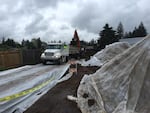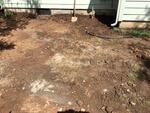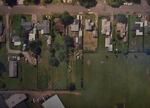
Naimah Shaheed and Craig McIntosh vacated their home while the Environmental Protection Agency oversaw the removal of more than 400 tons of lead-contaminated soil from their backyard.
Cassandra Profita/Earthfix
News of toxic lead in the air and water have many parents on high alert. Lead poisoning in children can cause permanent brain damage.
One Portland family is confronting that reality after a blood test showed their 1-year-old daughter had serious lead poisoning. But the lead wasn't coming from the air -- a concern for many Portland families who live near a glass-making plant. And it wasn't in the drinking water, like it has been in test results for schools in Tacoma.
It was coming from the family's own backyard.
Lately, Craig Mackintosh and Naimah Shaheed have been fielding a lot of questions from their doctor about their daughter Silver.
She's learning to talk, but is she talking enough? Does she need to see a development specialist?
"When the lead levels were high she kind of stopped growing," said Shaheed. "On her growth chart, there was a plateau. So the doctor's like: Is she speaking? What is she doing? We had this child, and she was clean. She was pure. And now, because of this situation, she's not."

A blood test showed 1-year-old Silver Shaheed McIntosh had more than twice the amount of lead in her body that Oregon considers the threshold for lead poisoning.
Cassandra Profita/EarthFix
The doctor has good reason to be concerned. Last year, Silver's blood test showed lead levels at 13 micrograms per deciliter. Oregon's threshold for lead poisoning is 5 micrograms.
"So, this particular situation was better than double that, and it's unknown how high it was at its highest," said Perry Cabot, who leads the lead prevention program for Multnomah County Health Department.
Cabot stepped in when the county learned about Silver's blood test. He said it's well known that lead is a neurotoxin that interferes with proper brain function.
"Basically, the brain is getting the wrong materials in there to help with signaling," he said. "And the neurons die, and that can cause IQ deficits in children with lead poisoning. Lead also damages just about every other major system in the body."
The problem, is experts can't predict exactly what lead will do to any particular child, he said. The damage might not be noticeable until a child takes a standardized test at school or starts having social problems. But Cabot says even then, no one will know if lead was the cause.

A recent blood test showed 1-year-old Silver Shaheed McIntosh's lead levels have dropped below the poison threshold.
Cassandra Profita/EarthFix
"It's just really sort of an unfortunate and rather scary waiting game for parents of lead-poisoned children to see how this will manifest," he said. "It's just known that it does and can and may."
When he first learned that his daughter had been poisoned, Mackintosh blamed himself.
"I immediately went into some hard self-reflection, self-loathing because I was certain it was me," he said.
He thought he was bringing lead home from his job building cabinets. But testing showed that his job clearly wasn't the culprit.
In the family’s backyard, workers in protective white suits pull a plastic sheet off a huge pile of toxic dirt. They immediately spray it down with water.

The Environmental Protection Agency is overseeing the removal of more than 400 tons of lead-contaminated soil in the family's backyard.
Courtesy of the EPA
"This is what we'll be moving today," said Dan Heister, project manager with the Environmental Protection Agency. He's overseeing the removal of more than 400 tons of lead-tainted soil on the property. "The levels were extremely elevated," he said. "As elevated as I've ever seen lead."
An excavator is scoops up the pile of dirt and puts it in a truck headed to a hazardous waste landfill.
"You see a kind of grayish or lighter material in there? It looks kind of like mold?" he said. "It's gritty. That was in a crust between a quarter and a half inch thick."
That, he says, is the visible layer of lead contamination that was hiding just a few inches under the grass in family's backyard. The soil here was about 12 percent lead. So thick, you could see it.

A few inches under the grass, clean-up crews found a layer of gritty, gray soil that was about 12 percent lead.
Courtesy of the EPA
Heister's best guess as to how the lead got there comes from old aerial photos. They show a rotating collection of junked cars in the yard. The previous owner was probably cutting them up – scattering the lead filler once used for auto body repairs – and selling the metal, he said.
It wasn't permitted, so no one knew about it. If anyone had reported it, Heister said, the city would have shut it down.
"That didn't happen," he said. "Silver was the unfortunate canary in the coal mine that brought it to our attention."
The lead in the backyard was so high that the family easily tracked it inside through the back door. Testing found lead on the kitchen floor at ten times levels of concern. Any time Silver was playing in the backyard or in the kitchen, she was at risk.

An old aerial photo of the property shows a variety of metal scraps scattered around the backyard.
Courtesy of the EPA
Last week, the family moved back into their house, which they've been renting. The owner is paying for the cleanup. And Silver's blood lead levels are dropped below the poison threshold.
"When we got back the new results, I wanted it to be zero so bad," Shaheed said. "I wasn't happy that it was – sorry, I'm tearing up – below the threshold. And then to find out it could be in her bones and what if she breaks a leg? Do we start from all over again?"
The lead cleanup is over, but the family's worries remain.
"The situation as a whole has been remarkably traumatic," Mackintosh said. "It's going to take a bit of time for us to become whole again. We don't know what Silver's future is going to be like, what this has done to her. Maybe nothing. Maybe something."
He advises others to check out old aerial photos of their homes to see what used to be there, and to get their soil tested – just in case.
Meanwhile, Cabot has assured the family that lead poisoning is not "an irreversible sentence," and that there are positive actions parents can take to help children with healthy brain development.
"We're learning that actually the brain is more plastic, and it's not this much damage has been done and it's a done deal and it's over," Cabot said. "Yes, there may have been some damage done, but we don't even know how much. We also know as a parent you can make good things happen for your child, and you can help that brain overcome things. There's a lot we can do to build our kids' capacities and futures and potential."
